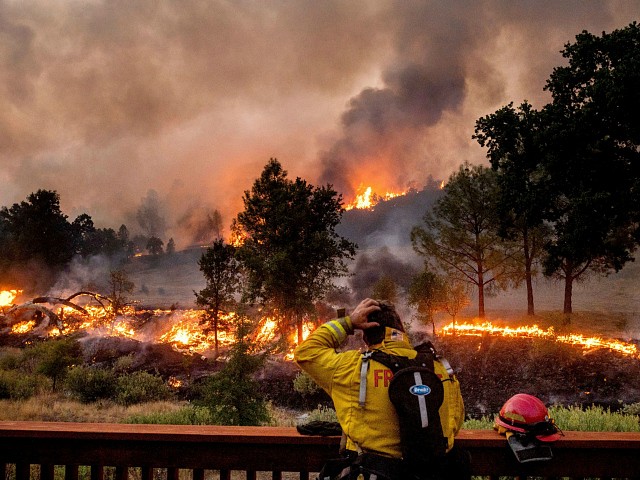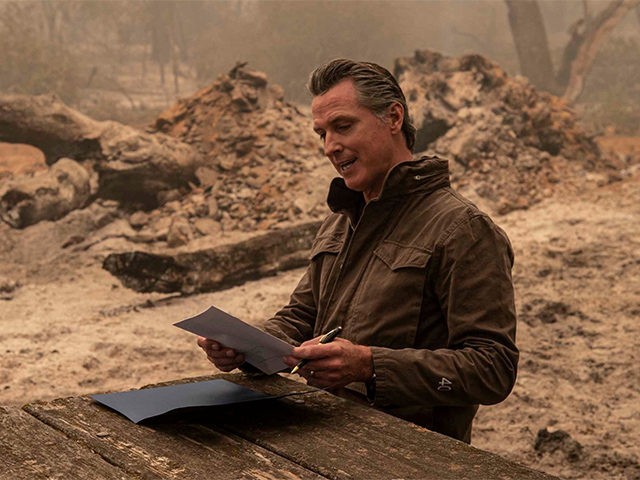The raging California wildfires of 2020 created enough carbon emissions to offset 16 years of reductions through the state’s green policies — twice over — according to a UCLA study published by Environmental Pollution.

A firefighter rubs his head while watching the LNU Lightning Complex fires spread through the Berryessa Estates neighborhood of unincorporated Napa County, Calif., on Friday, Aug. 21, 2020. The blaze forced thousands to flee and destroyed hundreds of homes and other structures. (AP Photo/Noah Berger)
As Breitbart News reported at the time, the wildfire season in 2020 was so intense that smoke from the fires reached cities on the East Coast of the United States. The CalFIRE state agency describes the fires as follows:
The 2020 California wildfire season was characterized by a record-setting year of wildfires that burned across the state of California as measured during the modern era of wildfire management and record keeping. As of the end of the year, nearly 10,000 fires had burned over 4.2 million acres, more than 4% of the state’s roughly 100 million acres of land, making 2020 the largest wildfire season recorded in California’s modern history. California’s August Complex fire has been described as the first “gigafire” as the area burned exceeded 1 million acres. The fire crossed seven counties and has been described as being larger than the state of Rhode Island. On August 19, 2020, California Governor Gavin Newsom reported that the state was battling 367 known fires, many sparked by intense thunderstorms on August 16–17. In early September 2020, a combination of a record-breaking heat wave, and Diablo and Santa Ana winds sparked more fires and explosively grew the active fires, with the August Complex more than doubling the Mendocino Complex’s size to become California’s largest recorded wildfire.
The study in Environmental Pollution, by two UCLA professors and one University of Chicago author, reports:
California experienced its most disastrous wildfire year on record in 2020. CalFire, the state agency responsible for leading California’s wildfire prevention and suppression, reports that 1.7 million hectares burned in 2020 (CalFire, 2022). Many of the worst fire years in California’s history have occurred in the past 20 years, with eighteen of the top 20 most destructive fires in terms of loss of life and property since 2000 and five in 2020 alone (CalFire, 2021). The 2020 fires have been followed by another extreme fire season with 1.0 million hectares burned in 2021.
…
Viewed from the perspective of what this means for wildfire emission reductions from all other sectors combined, if we compare to reductions from 2003 to 2019 from 483 to 418 mmt CO2e, the likely amount of increase from the fires is close to double all the emission reductions achieved in the state from 2003 to 2019.
Scientific American blames climate change for the fires.
However, that conclusion is still debated, as Breitbart News noted in 2021:
In his recent book, Unsettled: What Climate Science Tells Us, What It Doesn’t, and Why It Matters, Koonin considered the scientific data and concluded that “whatever influence a changing climate might have had on wildfires globally in recent decades, human factors unrelated to climate were dominant.” While climate change was “surely” playing a role by creating more fuel for fires, “factors other than climate must also play an important, if not dominant, role.” Many fires are caused by human activity; notably, Newsom has been criticized for poor forest management as he faces a recall election Tuesday.
Blaming climate change for forest fires has been a Democratic Party tradition since the Obama administration, when both the president and then-Gov. Jerry Brown cited climate change whenever wildfires burned across the state (or elsewhere). Scientists referred to it as “noble-cause corruption” — confusing the science for the sake of a “noble” objective.
Regardless, Gov. Gavin Newsom (D) failed to keep his promises on wildfire prevention. As Capital Public Radio and National Public Radio’s California Newsroom reported in 2022, Newsom’s “California Vegetation Treatment Program (CalVTP) “ha[d]n’t led to the completion of a single project” in his first term in office. Those same public news outlets had previously reported that Newsom had misstated the program’s progress.
Joel B. Pollak is Senior Editor-at-Large at Breitbart News and the host of Breitbart News Sunday on Sirius XM Patriot on Sunday evenings from 7 p.m. to 10 p.m. ET (4 p.m. to 7 p.m. PT). He is the author of the new biography, Rhoda: ‘Comrade Kadalie, You Are Out of Order’. He is also the author of the recent e-book, Neither Free nor Fair: The 2020 U.S. Presidential Election. He is a winner of the 2018 Robert Novak Journalism Alumni Fellowship. Follow him on Twitter at @joelpollak.

COMMENTS
Please let us know if you're having issues with commenting.